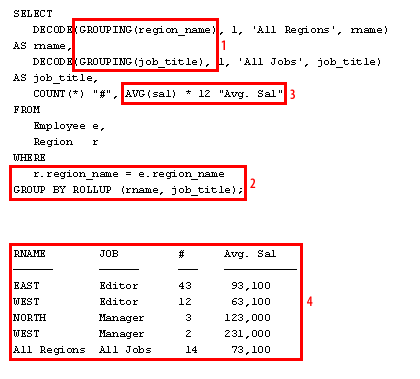Frequently used Oracle SQL BIFs
- to_char: The to_char function is especially useful for translating DATE datatypes and converting numeric columns to character representations.
- upper: The upper function is often used in queries that search text columns and ensure that retrievals of case-sensitive data are properly serviced.
- lower: The lower function is used to convert text to a lowercase representation and is quite useful when searching for strings in text.
- substr: The substr function is used to extract sub-strings in a large character column. This is commonly used to extract subsets from large character datatype columns such as subsets of telephone numbers.
- decode: The decode function is used to translate values in an SQL statement from a cryptic abbreviation to a readable value. For example, the decode function can translate two-digit State names into the full name of the State.
We must remember that these "built in functions" will cause the SQL optimizer to perform a full-table scan unless a function-based index is created to match the BIF. The most common example of an Oracle BIF is the use of the to_char function to translate a column with a DATE datatype. For example, the following query will display the number of STATSPACK snapshots that occurred in the month of March.
If we were using a generic index on the snap_time column, the to_char function would not be able to utilize the DATE index. However, with the use of built-in functions, an index can be built on
To get the "month" from a DATE datatype you simply:
select count(*) from perfstat.stats$snapshot where to_char(snap_time,'MON') = 'Mar';
If we were using a generic index on the snap_time column, the to_char function would not be able to utilize the DATE index. However, with the use of built-in functions, an index can be built on
to_char(snap_time,'Mon')and the SQL query could avoid a full-table scan.
to_char( dt_column, 'mm' ) -- returns 01..12 to_char( dt_column, 'MON' ) -- returns JAN, FEB, ... DEC in your language to_char( dt_column, 'Month' ) -- returns January, ... December in your language
GROUPING and ROLLUP BIFs

SELECT DECODE (GROUPING(region_name), 1, 'All Regions' , rname) AS name' DECODE (GROUPING(job_title), 1, 'All Jobs', job_title) AS job_title, COUNT(*) "#", AVG((sal) * 12 "Avg. Sal" FROM Employee e, Region r WHERE r.region_name = e.region_name GROUP BY ROLLUP (rname, job_title);1) Grouping to summarize 2) rolled up the totals 3) determine the average 4) benefits of built-in functions
- GROUPING tells Oracle to summarize. In this case we have extracted region, job title, and salary information and summarized it by region.
- We have rolled up the totals by region_name and by job_title.
- AVG provides a nationwide average for the number of employees and the average salary.
- If this were written without BIFs, it would have become a cumbersome and challenging programming task.